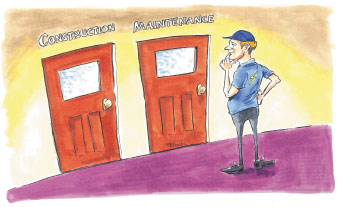The difference between construction and maintenance electricians

A successful electrician in today’s world must have a high level of knowledge and expertise. But what are some of the skills appropriate to today’s workplace?
First and foremost is knowledge. It’s essential to understand the basics of electrical circuitry and to have the mathematical know-how to calculate loads so that the wiring that feeds them will be sized correctly. None of this involves calculus or anything beyond relatively simple equations and a little number crunching with a handheld calculator. However, an orderly approach is needed and the patience to check and double check so that accuracy is assured. Electricians should keep in mind the image of a child sleeping in a top-floor bedroom of a building he or she has wired. One error in a series of simple calculations can spell disaster at some time in the future. So it is knowledge, backed up by impeccable workmanship that makes the difference.
ADVERTISEMENT
As a result, applicable building and electrical codes are the place to start.
In Australia, a separate electrician’s licence is required for each State or Territory. Of course there are those who ignore such formalities and choose to work under the table. These ‘trunk slammers’ usually do substandard work and are asking for trouble in the event of accident or malfunction.
The process of obtaining an electrician’s licence should be viewed as a valuable learning experience as opposed to an ordeal to be endured. Together with the diligent study of applicable electrical and building codes, gaining your licence means you are well on the road to success in this honourable profession.
But other factors are relevant as well. On-the-job experience working with knowledgeable individuals is a great way to gain expertise. Numerous textbooks are available, and the internet is also a valuable resource if used judiciously.
Electricians typically fall into two broad categories, construction and maintenance. The construction electrician does electrical installations in new buildings and renovation projects. The maintenance electrician is based in a medium or large-sized commercial or industrial facility. This division is not absolute; the categories overlap and there are gray areas. And at various times in an individual’s life, he or she may be either type of electrician or both simultaneously.
A construction electrician typically works as part of a crew engaged in new construction, often on a large scale project, such as a subdivision or high-rise.
The work may be fairly repetitive, as in drilling holes in studs, pulling wires or installing light fixtures, and the emphasis is on speed and efficiency if the undertaking is to be economically viable. Nevertheless, impeccable workmanship is essential, lest unseen defects are built into the work. A single fault can appear after occupancy and result in disaster. Another possibility is that a miscalculation, say in wire sizing, can be picked up on the inspection level and result in the need for costly rework.
Construction electricians must be well organised, hard workers who approach each job with a positive attitude. Required skills include an ability to work with various hand and power tools, an ability to read and interpret building plans, knowledge of relevant electrical and building codes and a willingness to work with and learn from co-workers.
Maintenance electricians, in contrast, are usually attached to a specific commercial or industrial facility. Small establishments may not warrant having a permanent electrician, so that outside contractors are brought in on an ‘as needed’ basis. Larger facilities have one or more electricians who do repair, maintenance and infrastructure expansion.
Generally, maintenance electricians are required to have more knowledge and expertise than their construction counterparts. This is because, depending on the facility, a very wide range of equipment is working every day, sometimes on a 24-hour basis. Large horsepower motors, with elaborate control systems may be present. Programmable logic controllers (PLCs) are everywhere in the industrial world. These are computerised machines that tell other machines within assembly lines or standing alone, what to do and when to do it. They also receive information from sensors throughout the workplace to ascertain whether everything is going smoothly and if human intervention is required. When production grinds to a stop due to PLC failure, it is the maintenance electrician who is called upon to solve the problem or call in outside help.
Often, the maintenance electrician is actually paid less than the construction electrician as the work may be physically less demanding, being based upon knowledge rather than speed and endurance.
But the maintenance electrician must be adept in the use of many tools – field strength meters, welding equipment, fibre optic tools, etc. A high degree of computer savvy is necessary since, to mention one instance, Ethernet networks have to be kept up and running and extended as the infrastructure acquires new functionality.
Then too, industrial wiring is run mostly in metal raceway. Bending and fitting conduit is an art form. The skill is acquired by a combination of study and experience. Construction electricians do this as well because a good proportion of their work is non-residential.
Many other procedures are performed by today’s electricians. Sooner or later, you will probably even have occasion to run a backhoe or aerial bucket truck.
Soldering is no longer ordinarily used to splice wires, having been replaced in the mid 1900s by the ubiquitous wire nut. Nevertheless, various solder techniques are still used extensively. Printed circuit boards have to be repaired if possible, and for a broken wire inside a power tool or two-way radio, solder is often the way to go.
As you can see, we have chosen to define ‘electrician’ fairly broadly. In an uncertain economic climate, this is a desirable approach. With extensive work capabilities, the electrician can become a valued player in this honourable profession.
In subsequent articles, we shall look at specific job skills, one at a time, and discuss ways to acquire the knowledge and expertise that is involved.
-
ADVERTISEMENT
-
ADVERTISEMENT

